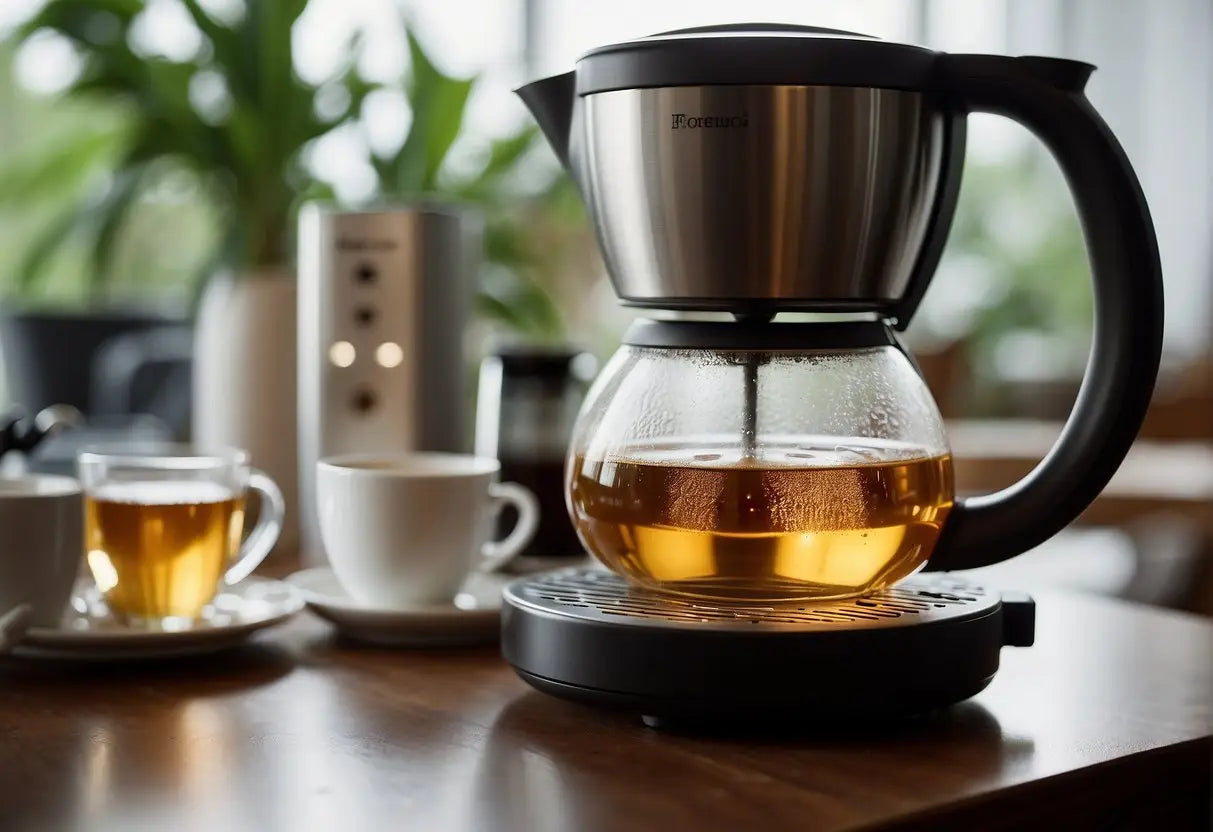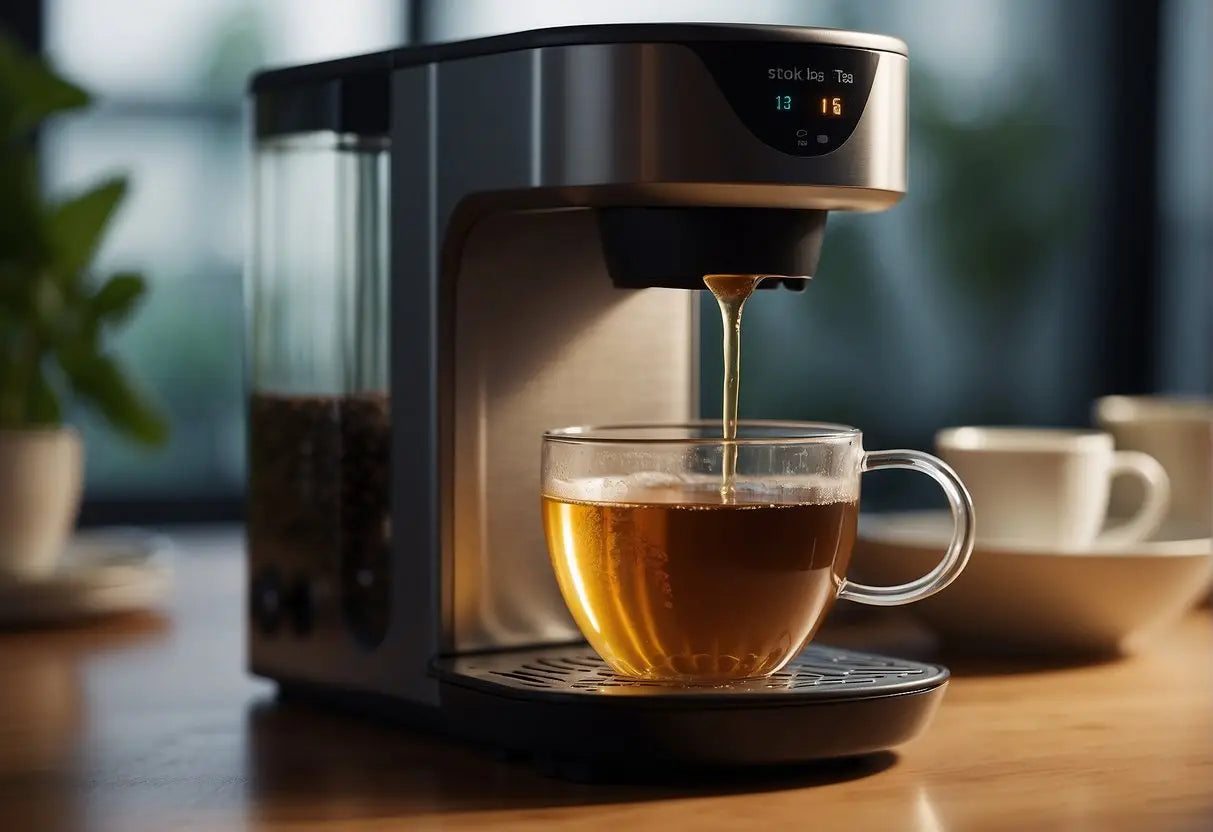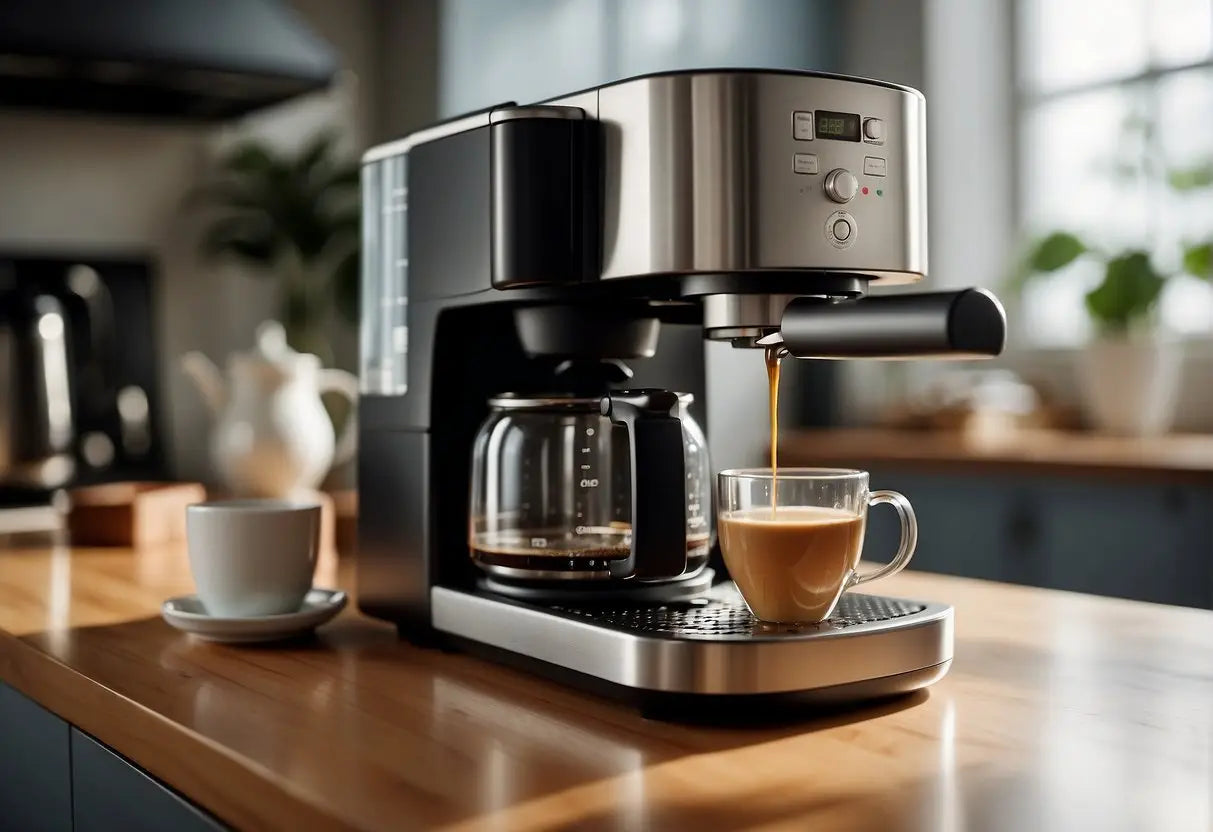Can You Make Tea in a Coffee Maker
Shop our Pu Erh Tea collections!
Brewing tea using a coffee maker is simpler than you might expect. Typically, a coffee maker heats water and runs it through coffee grounds. However, to use it for tea, you will bypass the coffee grounds and use tea bags or loose leaf tea instead.
Step-by-step Process:
Bestsellers
1. Fill the Reservoir: Begin by filling the coffee maker's reservoir with fresh, cold water. The amount of water should correspond to the number of cups you wish to brew.
2. Prepare the Tea: If you're using tea bags, place one tea bag into the coffee pot for each cup of tea. For loose leaf tea, a general guideline is 1 teaspoon per cup, which you can put into a clean filter in the basket.
3. Running the Machine: Turn on the coffee maker and let the water run through as it does when making coffee. The hot water will pass over the tea and infuse into the pot.
4. Steeping Time: Once the brewing cycle has completed, allow the tea to steep in the pot for an additional 3-5 minutes for optimal flavor.
5. Serving: After steeping, remove the tea bags or filter with loose leaves, pour the brewed tea into cups, and enjoy.
Tips:
- Always clean your coffee maker thoroughly to prevent coffee flavors from mingling with your tea.
- Adjust the amount of tea to suit your taste preference, more for a stronger brew, less for a milder one.
- For iced tea, double the tea concentration (since it will be diluted with ice) and cool after brewing.
Remember, the key is to ensure proper water temperature and steeping time for the type of tea you're making. Whether it's green, black, herbal, or oolong, each kind will have a recommended steeping time and temperature.
Types of Tea Suitable for Brewing in a Coffee Maker

Opting to use your coffee maker to brew tea can be both convenient and effective. Focus on using loose-leaf teas or tea bags that are comparable in size to standard coffee grounds.
Green Tea
For green tea, you'll find that your coffee maker can deliver a gentle brew. Set the machine to a lower temperature if possible, since green tea thrives around 150-180°F (65-80°C). Use one tea bag or one teaspoon of loose leaves per cup of water in the filter basket.
Black Tea
Black tea is robust and fares well with the typical brewing temperatures of a coffee maker. Use a standard ratio of one tea bag or one teaspoon of loose black tea per six to eight ounces of water for a full-flavored cup.
Herbal Tea
Herbal teas are diverse and can vary widely in brewing recommendations. However, most will brew nicely in a coffee maker. Use one tea bag or a heaping teaspoon of loose herbal tea per cup of water, and feel free to adjust to taste for lighter or stronger brews.
Lao Ban Zhang
Step-by-Step Guide to Brewing Tea in a Coffee Maker

To brew tea using a coffee maker, you'll need to adjust the typical coffee brewing process. Follow these steps to ensure a clear, properly infused cup of tea.
Water Preparation
1. Fill the Reservoir: Begin by filling the coffee maker's water reservoir with fresh, cold water. Avoid using hot water as it may not allow for proper tea infusion.
2. Check Water Temperature Settings: If your coffee maker has temperature settings, aim for a temperature between 195°F and 205°F, which is ideal for brewing most teas.
Tea Bag or Loose Leaf Placement
1. Tea Basket Preparation: Remove the coffee filter from the basket. If using a tea bag, place it directly into the basket. For loose leaf tea, use either a reusable coffee filter or place the loose tea in a tea infuser.
2. Amount to Use:
- Tea Bag: One tea bag per cup.
- Loose Leaf: Typically, use one teaspoon of tea for every six ounces of water.
Brewing Cycle
1. Start Brew Cycle: Turn on the coffee maker and allow the water to run through the tea in the brewing basket.
2. Monitoring Brew Time:
- Black, Herbal, or Oolong Teas: Allow to brew for the full cycle.
- Green or White Teas: Consider stopping the cycle early (around 1-2 minutes) to prevent over-steeping, which can cause bitterness.
Post-Brewing Steps
1. Remove Used Tea: Immediately after the brew cycle, remove the used tea bag or infuser to avoid further steeping.
2. Clean Coffee Maker: Rinse the basket and carafe thoroughly to remove any tea residue, preventing flavors from mingling with future brews of coffee or tea.
Cleaning the Coffee Maker After Brewing Tea

After brewing tea in a coffee maker, it is essential to clean the equipment properly to prevent flavor contamination between your tea and coffee.
Rinsing the Equipment
Begin by removing any tea bags or leaves and discard them. Then, run a full cycle with just water, making sure to empty the carafe between cycles. This process removes the majority of tea residue.
Steps:
- Empty the carafe and dispose of tea remnants.
- Fill the reservoir with clean water and run a complete brew cycle.
- Repeat the water cycle if you still detect tea odors or residues.
Deep Cleaning for Flavor Preservation
For a more thorough cleaning, use a mixture of water and vinegar to dissolve mineral deposits and lingering flavors.
Instructions:
- Mix one part white vinegar to two parts water.
- Pour this solution into the water reservoir and run a half brew cycle, pausing for 30 minutes before finishing the cycle.
- Run two or three additional cycles with clean water to eliminate any vinegar smell.
| Step | Action |
|---|---|
| Mix Cleaning Solution | 1 part vinegar, 2 parts water |
| Run Half Brew Cycle | Start cycle, then pause for 30 minutes |
| Finish Brew Cycle | Complete the interrupted cleaning cycle |
| Rinse with Water | Run 2-3 cycles with water to remove vinegar residue |
Remember to clean the carafe and basket with soapy water. Rinse all parts well and let them dry completely before the next use.
Pros and Cons of Using a Coffee Maker for Tea
Making tea in a coffee maker is a convenient alternative to traditional methods. It can offer time-saving benefits but also comes with potential drawbacks that affect the quality of your tea.
Advantages
- Speed: You typically brew coffee rapidly in a coffee maker, and this holds true for tea as well. This means you can have your cup of tea ready in a few minutes.
- Convenience: If you already own a coffee maker, there's no need to invest in a separate teapot or kettle, saving space and simplifying your kitchen setup.
Disadvantages
- Flavor Cross-Contamination: Residual coffee oils and flavors inside the coffee maker can transfer to your tea, altering its taste and purity.
- Temperature Control: Coffee makers often do not reach the optimal temperature required for different types of tea, which can result in a subpar infusion.
Comparing Coffee Maker Tea Brewing to Traditional Methods
When you brew tea using a coffee maker, the process is quite different from traditional methods. Utilizing a coffee maker, the water is generally heated to a temperature suitable for coffee, which tends to be higher than the ideal temperature for most teas. This could affect the flavor of delicate teas like green or white varieties.
Traditional Brewing:
- You typically heat water separately to the specific temperature needed for the type of tea you're making.
- Steeping time is easier to control manually, allowing for a precise brew.
- Loose tea leaves have more room to unfurl in a teapot, which can result in better flavor extraction.
Coffee Maker Brewing:
- Water temperature may be too high, potentially leading to a bitter taste.
- Steeping is less controlled, which can affect the nuances of the tea's flavor profile.
- You are limited by the size of the coffee maker's basket for tea leaves or bags, possibly restricting full flavor release.
Using a coffee maker, you pour water into the reservoir, place your tea bag or tea leaves in the basket, and start the brew cycle. The water flows through the tea, similarly to coffee, and drips into the pot below. Remember, the setup and cleaning process tend to be straightforward with a coffee maker, offering convenience and speed.
Traditional methods often involve pre-warming the teapot, properly boiling water, adding tea to the teapot, and steeping for the desired amount of time. Each step requires attention and care to ensure the optimal brewing of your tea leaves.
| Attribute | Traditional Brewing | Coffee Maker Brewing |
|---|---|---|
| Temperature Control | Precise | Less precise |
| Steeping Control | Manual - more accurate | Automatic - less accurate |
| Flavor Extraction | Optimal for loose leaves | May be limited by basket size |
| Convenience | More steps involved | Simpler and faster |
| Cleaning | Requires cleaning teapot and accessories | Coffee maker needs regular cleaning |
In summary, you have to weigh convenience against the potential compromises in the quality of the tea when choosing between a traditional method and using a coffee maker.
Safety Precautions and Considerations
When using a coffee maker to brew tea, safety is paramount. It's critical to ensure that the appliance you choose to use is suitable for brewing tea. Here are some key points to keep in mind:
-
Electrical Safety: Always check the coffee maker for any signs of electrical damage before use. If you notice frayed cords or exposed wires, do not use the machine.
-
Temperature Settings: Coffee makers typically heat water to higher temperatures than what is ideal for tea. Be cautious to avoid burns and ensure the machine does not overheat.
-
Cleaning: Coffee oils can remain in the machine and may affect the flavor of your tea. Prior to brewing tea, thoroughly clean all parts that will come in contact with the water or tea.
| Do | Don't |
|---|---|
| Ensure the coffee maker is in good working condition. | Use a damaged or malfunctioning coffee maker. |
| Follow the manufacturer’s instructions for brewing tea. | Assume all coffee makers are suitable for tea preparation. |
| Unplug the coffee maker when not in use. | Leave the coffee maker plugged in when not in use. |
-
Material Compatibility: If you're using a pod-style coffee maker, check that any tea pods are compatible with the machine to avoid damage.
-
Water Quality: Use fresh, cold water to fill the reservoir to avoid mineral buildup and to ensure the best tea flavor. Do not use previously boiled or distilled water.
By paying attention to these precautions and considerations, you can safely enjoy tea made in a coffee maker.
Tips and Tricks for Optimal Tea Flavor

When using a coffee maker to brew tea, the goal is to extract the full flavor and aroma from your tea leaves. Follow these guidelines to enhance your tea experience:
-
Water Quality: Start with cold, fresh water, as it impacts the taste. Using filtered or bottled water can be preferable if your tap water has a strong taste or odor.
-
Temperature Control: Different teas require different temperatures. For example, green tea thrives at lower temperatures (around 175°F), while black tea performs well with near-boiling water. If your coffee maker does not allow temperature control, run water through it first to cool it slightly for delicate teas.
-
Tea Type: Use loose-leaf teas or tea bags specifically designed for hot brewing. Here are ideal quantities:
- 1 teaspoon of loose tea per 6 oz of water
- 1 tea bag for a single cup (roughly 8 oz)
-
Cleaning: Thoroughly clean the coffee maker to prevent coffee residue from affecting tea flavor. Pay extra attention to the carafe and the brewing basket.
-
Pre-infusion: If your coffee maker has a pre-infusion or bloom cycle, enable it. This step dampens the tea leaves, aiding in a more even and full extraction of flavors.
-
Steeping Time: Allow the tea to steep in the carafe for an extra few minutes after the brewing cycle, especially for larger quantities, mimicking a traditional steeping process.
-
Maintenance: Regularly descale and clean your coffee maker, ensuring it remains in optimal condition for both tea and coffee brewing.
← Older post Newer post →











